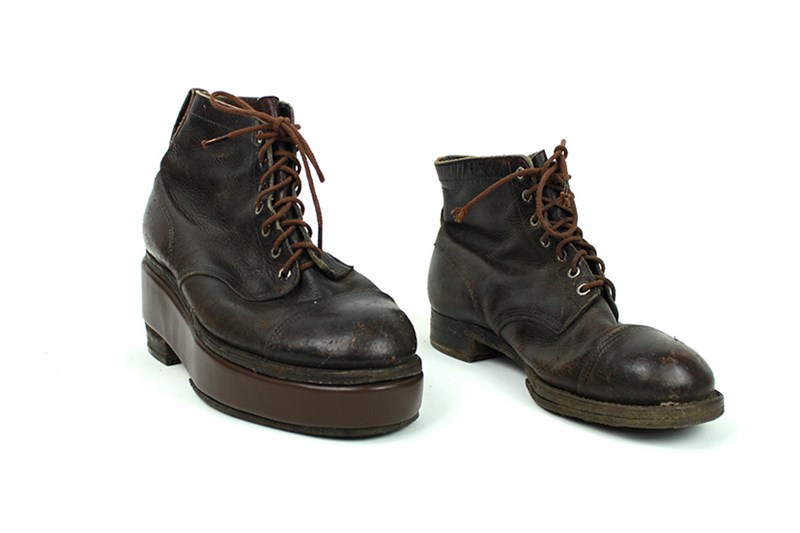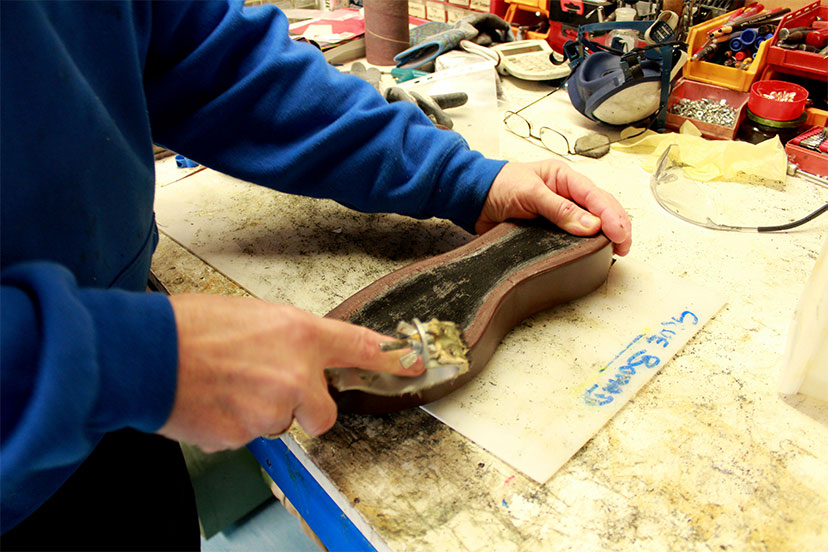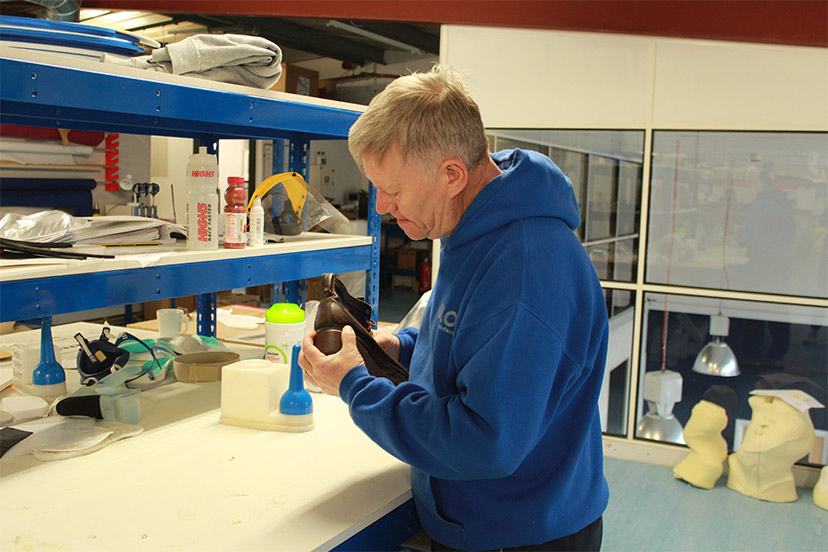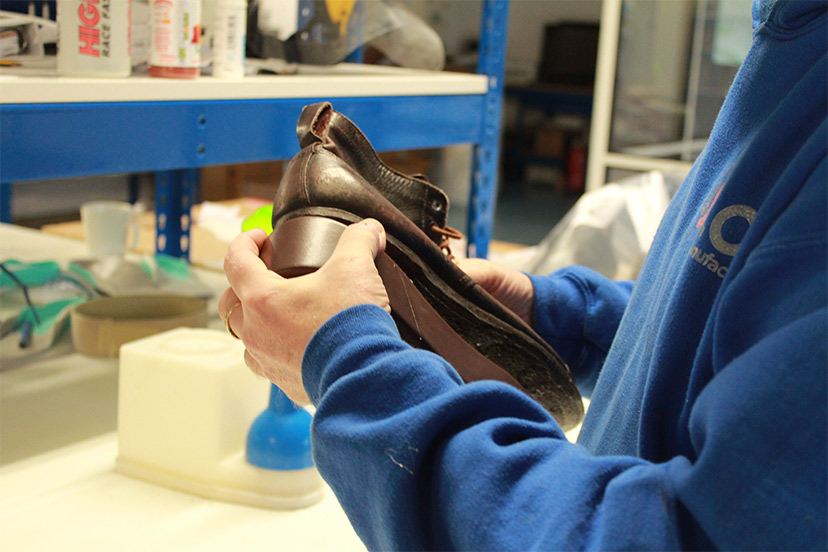
26 December 2018
Back in April, the London Orthotic Consultancy was approached by the BBC costume department with a request to make a footwear adaption prop for the 90-minute Christmas edition of Call the Midwife which aired on 25th December 2018. The period drama, based on the memoirs of Jennifer Worth, closely follows several nurse midwives working in the East End of London during the late 1950s and early 1960s.
Clinician David Williams, who made the orthosis, comments on the unusual, but exciting request; “It’s a difficult job trying to make a person who walks normally look like they have a club foot, for sure! The orthosis needed to go into period footwear – like hobnail boots – with a medical adaption, in order to emulate club foot presentation.” To do this, a traditional leather raise, sometimes referred to as an insert, was created and then added to the sole of the shoe.


Above: Senior orthotic technician Sean adding the insert to shoe
“Phillip Gipps, senior orthotist at LOC, distressed the leather to match the rest of the boot, in traditional, battered brown leather and the final result was a shoe that was three inches higher than the other – certainly not advisable for comfort! Ordinarily, we wouldn’t recommend this at home, walking with one foot raised several inches above the other is likely to cause you to pull a muscle!”

The Christmas edition marked the beginning of its eighth season on BBC One, with the rest of the series to follow in 2019. Writer for the show, Heidi Thomas, is a well-known stickler for period accuracy and the show has not shied away from using prosthetics in the past. For each birthing scene, both a real and prosthetic baby made from medical grade silicon (the same kind used in artificial limbs) are used.
Club foot, sometimes referred to as talipes is a congenital deformity that can affect either one or both feet. A baby with club foot will have one or both feet pointing down and inwards and, without treatment, a person suffering club foot will appear to walk on the sides of their feet or ankles. When proper treatment of club foot with bracing has been started shortly after birth, good clinical correction can be obtained in most cases.
Club foot treatment has a long, controversial and varied history. It wasn’t until half a century ago that Spanish physician Dr Ignacio V Ponseti suggested serial plaster casting was favourable for treating club foot with better long-term results and less short-term pain. Plaster casting every 6-8 weeks allows the tendons and muscles to be aligned correctly and makes the most of babies’ flexible ligaments – this is known as the Ponseti method, the gold standard in club foot treatment in the UK and most of the world.
The Ponseti technique involves the baby's foot being gently manipulated from its incorrect inward-facing position to a more correct outward position, then being put in a cast on a weekly basis. Casting continues for around five to eight weeks and after this stage, a tenotomy (small surgical incision) of the achilles tendon is performed under local anaesthetic to release the foot.
Traditionally, many babies will then go on to have a traditional ‘boots and bar’ brace, comprised of special shoes attached to each other by a metal bar the same width as the baby’s shoulders. The brace keeps the club foot fixed in the corrective position achieved during the casting phase.
At LOC, we treat club foot deformity with the Cunningham brace (also known as the Dynamic Torsional KAFO or DTKAFO) which is a flexible brace developed by a prosthetist and orthotist Jerald Cunningham in Maine, USA. The Cunningham brace was developed to offer an alternative to the boots and bar method, which can be difficult for parents to put on and keep on with wriggling babies. Other complaints are that children can find it difficult to sleep in them.
Like the boots and bar brace, it keeps the feet in the same corrective position and gently stretches the muscles, but, unlike traditional braces, the Cunningham brace is only fixed to the affected foot, so accommodates for day to day activities like crawling. Increased comfort for the baby means it’s more likely for compliance rates to go up – i.e. parents don’t have to worry about their child’s discomfort and it means they are more likely to stick with treatment.
If you would like to know more about our club foot services, or indeed our bespoke orthotics manufacturing service, please do get in touch today by giving us a call on 020 89749989.
Club foot, or clubfoot, is the general name given for a medical condition called congenital talipes equinovarus (CTEV). Congenital means that you’re born with the condition, which can occur in one or both feet. It is quite common, occurring in around one in every 1,000 babies born in the UK.
The Ponseti method involves manipulation and repeated weekly casting for about five to eight weeks. After that, a small procedure called a tenotomy is carried out under local anaesthetic to lengthen the tight heel cord – known as the Achilles tendon – in the back of your ankle. The treatment follows very strict, well-understood protocols and is the gold standard in corrective treatment for club foot. Indeed, the procedure is used and endorsed by Great Ormond Street.
The Cunningham Brace was designed by Jerald Cunningham, who runs his own clinic in the US. It works using a firm strap around the thigh and a spring that holds the brace up against the bottom of the foot. This means that the brace is always gently stretching your baby’s foot into the correct position, in a similar way that a therapist applies manipulation.
Jerald developed the brace at the request of an orthopaedic surgeon and colleague who saw how distressing the boots and bar process was for many children and parents. Jerald has worked on the design for more than 10 years, tweaking as he goes, based on x-ray evidence after every patient fitting.
No problem. Often parents come to us after they’ve tried persevering with the boots and bar treatment for a few months. It may change our treatment plan a little and your child might need treatment for a bit longer, but the process will essentially be the same.
At the moment we can fit the brace at our clinics in Kingston-upon-Thames and Bristol; in addition, we can do follow up appointments at our Manchester clinic. There is a certain amount we can do virtually, but your first fitting would need to be done in person.
We have the following facilities and amenities at our Kingston Upon Thames location:
We also have the Gait Laboratory for orthotics patients and Onsite Manufacturing for speedy turnarounds and adjustments whilst you wait.